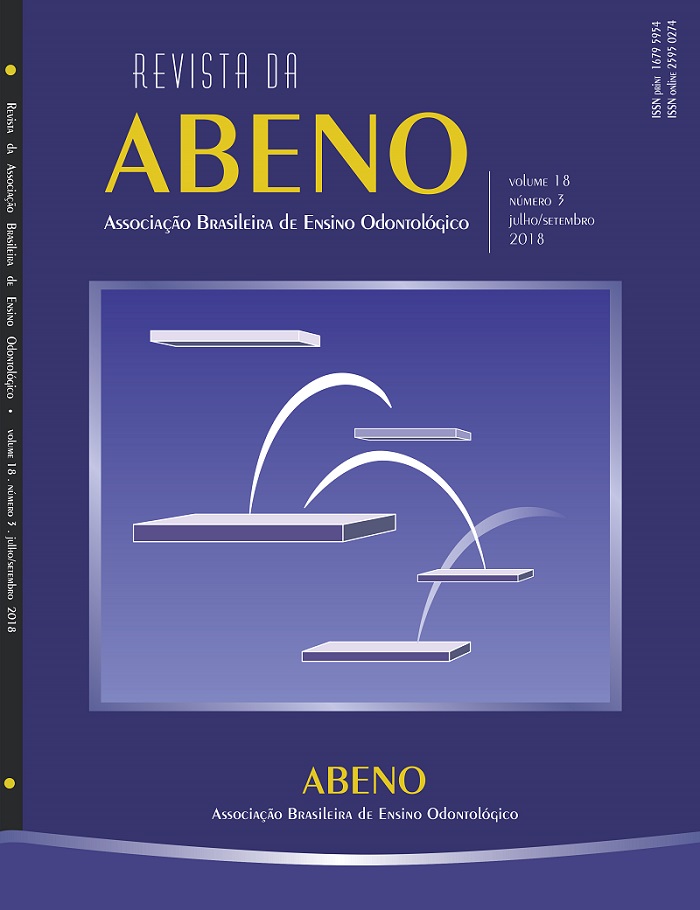Identification of the fungal population in air samples collected at Pediatric Dentistry teaching clinic
DOI:
https://doi.org/10.30979/rev.abeno.v18i3.566Keywords:
Bacterial Infections and Mycoses. Aerosols. Dental Clinics. Pediatric Dentistry. Infection Control.Abstract
Infectious agents can be transmitted via microscopic particles suspended in the air and secretions present on contaminated surfaces of instruments and equipment. Indoor airborne contaminants include fungi, bacteria and viruses, which come from outside air, the air conditioning system, the building, furniture, carpet and their occupants. Most procedures performed at the dental clinic release large amounts of aerosols, minute particles that remain for several hours in the air and may contain several microorganisms, among them fungi. In teaching clinics, this contamination is greater due to the high number of occupants and procedures performed at the same time. By knowing the fungal genera to which their patients are exposed, the professional can minimize the risks of infection, adopting practices of hygiene of the environment and air that can aid in the prevention of diseases. The fungi check was performed by the plate sedimentation method, which is useful for the analysis of the quantity and quality of fungi present in internal and external environments. Species belonging to the genus Aspergillus, Fusarium, Cladosporium, Nigrospora and Penicillium were identified, most frequently found Penicillium and Aspergillus genera from external and internal environment.
Downloads
References
Zemouri C, de Soet H, Crielaard W, Laheij A. A scoping review on bio-aerosols in healthcare and the dental environment. Plos One. 2017;12(5):e0178007. DOI: 10.1371/ journal.pone.0178007.
Brasil. Lei de Diretrizes e Bases da Educação Nacional. Lei no 9.394/1996 – Lei no 4.024/1961 artigo 43. Senado Federal. Brasília: Coordenação de Edições Técnicas; 2017.
Kadaifciler D, Cotuk A. Microbial contamination of dental unit waterlines and effect on quality of indoor air. Environ Monit Assess. 2014; 186(6):3431-44.
Boch T, Reinwald M, Postina P, Cornely O, Vehreschild J, Spiess B, et al. Identification of invasive fungal diseases in immunocompromised patients by combining an Aspergillus specific PCR with a multifungal DNA-microarray from primary clinical samples. Mycoses. 2015; 58(12):735-45.
Rogawansamy S, Gaskin S, Taylor M, Pisaniello D. An evaluation of antifungal agents for the treatment of fungal contamination in indoor air environments. Int J Environ Res Public Health. 2015; 12(6):6319-32.
Brasil. Cartilha de proteção respiratória contra agentes biológicos para profissionais da saúde. Brasília: Ministério da Saúde, 2009.
Brasil. Ministério da Saúde. Agência Nacional de Vigilância Sanitária. Resolução nº 9, de 16 de janeiro de 2003. Orientação técnica sobre padrões referenciais de qualidade do ar interior em ambientes climatizados artificialmente de uso público e coletivo. Diário Oficial da União, Brasília, DF, 20 jan. 2003.
Barreto ACB, Vasconcelos CPP, Girao CMS, Rocha MMNP, Mota OML, Pereira SLS. Contaminação do ambiente odontológico por aerossóis durante atendimento clínico com uso de ultrassom. Braz J Periodontol. 2011; 21: 79-84.
Jurado S, Bankoff A, Sanchez A. Indoor air quality in Brazilian universities. Int J Environ Res Public Health. 2014; 11(7): 7081-93.
Sousa KS, Fortuna JL. Microrganismos em ambientes climatizados de consultórios odontológicos em uma cidade do extremo sul da Bahia. Rev Baiana Saúde Pública. 2011; 35(2): 250-63.
Segers F, Meijer M, Houbraken J, Samson R, Wösten H, Dijksterhuis J. Xerotolerant Cladosporium sphaerospermum are predominant on indoor surfaces compared to other Cladosporium Species. Plos One. 2015; 10(12):e0145415. DOI: 10.1371/ journal.pone.0145415.
Kolwijck E, van de Veerdonk F. The potential impact of the pulmonary microbiome on immunopathogenesis of Aspergillus-related lung disease. Eur J Immunol. 2014; 44(11): 3156-65.
Hayleeyesus SF, Manaye AM. Microbiological quality of indoor air in university libraries. Asian Pac J Trop Biomed. 2014; 4(1):321-17.
de Sant’anna JB, Santos CF, Carneiro JA, Coutinho FN. Investigação de fungos anemófilos em ambiente cirúrgico do Hospital Regional de Brazlândia-DF. Proceedings COPEC. 2010; 7(10): 409-12.
Guevara-Suarez M, Sutton D, Cano-Lira J, García D, Martin-Vicente A, Gené J, et al. Identification and antifungal susceptibility of Penicillium-like fungi from clinical samples in the United States. J Clin Microbol. 2016; 54(8): 2155-61.
Melo LLS, Lima AMC, Damasceno CAV, Vieira ALP. Flora fúngica no ambiente da Unidade de Terapia Intensiva Pediátrica e Neonatal em hospital terciário. Rev Paul Pediatr. 2009; 27(3):303-8.
Haleem Khan AA, Mohan Karuppayil S. Fungal pollution of indoor environments and its management. Saudi J Biol Sci. 2012; 19(4):405-26.
Frankel M, Hansen E, Madsen A. Effect of relative humidity on the
aerosolization and total inflammatory potential of fungal particles from dust-inoculated gypsum boards. Indoor Air. 2014;24(1):16-28.
Neder RN. Microbiologia: manual de laboratório. São Paulo, Brasil: Editora Nobel; 1992.
Ministério da Saúde (BR). Biossegurança em saúde: prioridades e estratégias de ação. Brasília: Ministério da Saúde; 2010.
Downloads
Published
How to Cite
Issue
Section
License
Autores que publicam nesta revista concordam com os seguintes termos:
a) Autores mantém os direitos autorais e concedem à revista o direito de primeira publicação, com o trabalho simultaneamente licenciado sob a Licença Creative Commons Attribution que permite o compartilhamento do trabalho com reconhecimento da autoria e publicação inicial nesta revista.
b) Autores têm autorização para assumir contratos adicionais separadamente, para distribuição não-exclusiva da versão do trabalho publicada nesta revista (ex.: publicar em repositório institucional ou como capítulo de livro), com reconhecimento de autoria e publicação inicial nesta revista.
c) Autores têm permissão e são estimulados a publicar e distribuir seu trabalho online (ex.: em repositórios institucionais ou na sua página pessoal) a qualquer ponto antes ou durante o processo editorial, já que isso pode gerar alterações produtivas, bem como aumentar o impacto e a citação do trabalho publicado (Veja O Efeito do Acesso Livre).






